Selective deposition of silicon-containing films
a technology of silicon-containing films and selective deposition, which is applied in the direction of polycrystalline material growth, crystal growth process, chemically reactive gas, etc., can solve the problems of few advantages, few studies performed, and the development of commercial sources of trisilane not yet recognized, so as to improve the surface the quality of the deposited layer. the effect of high quality
- Summary
- Abstract
- Description
- Claims
- Application Information
AI Technical Summary
Benefits of technology
Problems solved by technology
Method used
Image
Examples
example 1
[0153] This example illustrates the selective deposition of epitaxial silicon films over mixed morphology substrates.
[0154] An eight-inch unpatterned Si wafer substrate and separate wafer with a fully oxidized (1000 Å) surface were loaded into an Epsilon E2500™ reactor system. The substrate was then introduced into the reactor system at 900° C., at a hydrogen flow rate of 20 slm, and the substrate was allowed to stabilize for 1 minute. The hydrogen flow was then shut down as the temperature of the substrate was reduced to 550° C. The substrate was then allowed to stabilize for 10 seconds, after which time a flow of 50 mg / min of trisilane was introduced for 10 minutes. A flow of 200 sccm chlorine gas and 100 sccm of 1% phosphine was simultaneously provided and the deposition was conducted at a deposition pressure of about 6 Torr. A continuous, uniform phosphorous-doped Si film having a thickness of about 500 Å was selectively deposited (deposition rate of 5 nm / min) over the single c...
example 2
[0155] A deposition process was conducted as described in Example 1 except that a separate wafer having a silicon nitride surface was loaded into the reactor system instead of the separate wafer with a silicon oxide surface. An epitaxial phosphorous-doped Si film was selectively deposited on the silicon wafer, with essentially no deposition on the silicon nitride surface. As in Example 1, the deposited phosphorous-doped Si film had excellent epitaxial quality and a resistivity of about 0.35 mΩ·cm.
PUM
| Property | Measurement | Unit |
|---|---|---|
| temperature | aaaaa | aaaaa |
| temperature | aaaaa | aaaaa |
| pressure | aaaaa | aaaaa |
Abstract
Description
Claims
Application Information
 Login to View More
Login to View More - R&D
- Intellectual Property
- Life Sciences
- Materials
- Tech Scout
- Unparalleled Data Quality
- Higher Quality Content
- 60% Fewer Hallucinations
Browse by: Latest US Patents, China's latest patents, Technical Efficacy Thesaurus, Application Domain, Technology Topic, Popular Technical Reports.
© 2025 PatSnap. All rights reserved.Legal|Privacy policy|Modern Slavery Act Transparency Statement|Sitemap|About US| Contact US: help@patsnap.com



